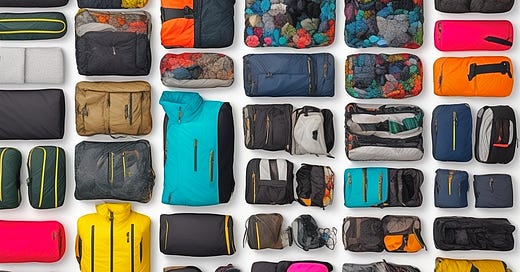You’re reading From the Desk, a monthly newsletter by Miles Farnsworth about the arts, spirituality, and the good life. I wrote a book about living in New Zealand as a volunteer missionary. Subscribe below to get my monthly post in your inbox.
I love gear.
After biking, rafting, and camping my way through the summer, pondering the merits of my gear along the way, I became more and more convinced that the love of gear is a staple of the human condition (or at least my human condition). What do I work for? Money to buy gear. What do we talk about with my friends and family? The gear I have, the gear I want, and the uses of our gear. Gear is life.
While that’s stretching it a little, I do find gear a fascinating topic. Where does the love of gear originate? Perhaps as a child, when you received your first pair of sneakers with the promise from your father that the shoes were “guaranteed to make a kid run faster and jump higher.”1
After that, you’re hooked. Gear becomes inextricably tied to performance, to making you into something more than your mere mortality.
By this definition, gear has far-reaching applications. It’s not just for sports or the outdoors—kitchen gadgets, clothing, tools, furniture, and makeup all qualify as gear. Even relaxation is better with the right gear. Whatever you acquire to do the job, that’s gear.2
I can remember some of the best pieces of gear I’ve ever owned. One was my Camelbak H.A.W.G. backpack and bladder. The pack, a birthday gift, was linked to a Farnsworth Family rite of passage: on your 12th birthday, you climbed the 14-mile out-and-back trail up to Mount Timpanogos. It featured a 3-liter bladder, one I still use to this day, even after the pack itself went to gear heaven.
There’s my Kathmandu Altric200 maroon fleece jacket with double front-pocket button snaps. I got it from a clearance rack at the Kathmandu Outlet on Mercer Street in Wellington, NZ back in 2013. It dresses up nice enough to wear to church and makes for the perfect second layer during the shoulder seasons. I’ve searched for years for an adequate replacement with no luck, and so I intend to wear it until it’s nothing more than a tattered rag, which probably won’t happen for another twenty years.
All the best gear I’ve owned comes flooding back into my mind like warm honey, rich with nostalgic satisfaction: the clam-digger shorts worn by at least three of my brothers and passed down like holy garb, the Micro-Cube guitar amp, a black wool pea coat, waterproof Ecco Gore-wear boots handed to me by a fellow-missionary who couldn’t fit them in his luggage home.
If you like gear, you probably agree that talking about gear is nearly as fun as using it. Whenever I’ve hiked, biked, ran, played music, or traveled, gear becomes the main topic of conversation. Where did you find it? How long have you had it? Did you get a discount?
As you talk with other gear enthusiasts, you learn that they all have a unique philosophy regarding gear acquisition. Here are just a few approaches:
The Brand Loyalists: They may as well be a walking catalog. Fender guitar, Fender strap, Fender cable, Fender amp.
The Deal Hunters: Don’t expect them to pay a penny more than the lowest absolute price they can find.
The Pampered: These gear junkies will spend any amount of money necessary to have the top-of-the-line gear. Quality is inherent, but they’re willing to pay any amount for the best (and to tell you that they own the best).
The Minimalists: Equipped with the simplest of tools, they believe it’s the person, not the accessories, that drive success. Yet they love telling you how much something weighs.
The Buy-it-for-Lifers: It may come at a cost, but they’ll hunt for a product that’s going to last as long as possible.
The Thrifters: Don’t expect them to shell out for something new. You’ll find them sorting through piles of junk for the diamond in the rough.
My Gear Buying Philosophy
Allow me to share my philosophy, one forged by my own father, enhanced in my Economics 101 class (a class I pulled a “C+” in, so proceed with caution), and solidified by being a bit of a tight-wad.
I call my philosophy the “Point of Unrecognized Satisfaction”.
First, a quick econ lesson. The Law of Marginal Utility states that utility (aka happiness, satisfaction, value) decreases with each additional quantity of an item you possess until eventually, your utility decreases.
For example, your happiness with a slice of pizza increases with each additional slice, but the incremental happiness from that next slice is always less than the first. Eventually, you’re so sick of pizza that your satisfaction begins to decrease.
At some point, there’s an inflection, and your utility is at its max.
My gear philosophy is rooted in these principles, but instead of utility, I’m talking about usability. The inflection point, or my Point of Unrecognized Satisfaction, occurs when I no longer recognize any additional usability. It’s completely arbitrary, but it’s an honest recognition that at some point, I’ll be paying for unrecognized usability.
Let me illustrate my philosophy with guitars. I’ve been playing the acoustic guitar since I was about 12 years old. In that time, I’ve held a lot of different models. All guitars are fundamentally the same—six strings, 20ish frets, makes noise when plucked. Yet not all have the same usability, or in this case, playability.
A cheap guitar is almost unplayable. The string action is too high, it buzzes, your fingers kill, and it sounds like a tin can. As illustrated in the chart above, the difference between a $100 guitar and a $300 guitar is astronomical. A masterful guitarist could make a $300 guitar sound like a dream.
I believe, though other guitarists may disagree, that usability levels off around the $600-800 mark. The quality can still improve, but at some point, the price you’re paying doesn’t necessarily translate into a more playable (or better-sounding) guitar. $600-800 happens to be my Point of Unrecognized Satisfaction. I’m essentially admitting that I can’t tell the difference between playing an $800 guitar and a $1,600 guitar. I’m simply not good enough! By understanding my limitations and the curve of marginal usability, I’m able to pinpoint exactly where I should be buying a guitar.
One of the enjoyable parts about gear is figuring out how I see this curve and where I find the Point of Unrecognized Satisfaction. Sometimes it’s a painful lesson.
I got back into running with a pair of Nike Pegasus shoes. I didn’t know it at the time, being too new to running, but these are a quality, no-nonsense shoe. When they wore out, I went online and bought a cheap pair of Adidas shoes for around $45.
The very first run gave me monstrous cramps in each of my calves and spurred on a bought of plantar fasciitis I’m still fighting three years later. Two more runs in the crappy Adidas confirmed I’d made a terrible mistake. I threw them out and bought a legit pair of runners, and have been willing to shell out for quality running footwear ever since (though I’m starting to use relaygoods.com to get them at a discount).
I open the floor to you, fellow gear-lovers. What’s your buying philosophy? What’s the best piece of gear you’ve ever owned? Join me in the celebration of great gear.
If you don’t know the reference, I’m not telling you.
This is an important distinction. Art and collectibles are not gear, no matter how much joy they bring us.







One thing that always stuck with me about guitars is that (for instance) a $600 “lesser” brand is better than the same priced “Big Boy” professional brand. Like, a $600 Yamaha will be one of their high-quality top-of-the-line guitars, whereas a $600 Martin gets you their kitchen counter material (like Formica) guitar, made in Mexico. (The “good” Martins come from Nazareth, Pennsylvania.) And in the “good” ones of a “brand name” up-scale [more money] model, there’s a point at which you’re no longer paying for sound quality, but rather “stage appeal.” Or “guitar-player” appeal. More inlay work, flashier sound hole rosette work, artistic peg-head embellishment, cool looking fret markets (as opposed to the most common - a “dot.” I’ve got a nice older [70s] Martin, a D -18, dot markers, no extra inlay.
I love the way it sounds, as it has a “lightness” to it for my finger -picking style. I got it used for less than 1/3 the price of a new one. (In the realm of automobiles, newer = better, in terms of wear and tear. In the guitar realm, playing it kind of “forms the wood a bit and “seasons” it over time. Often times older sounds and / or plays better.)
Thinking that if my D -18 sounds that good, maybe if I can “trade-up” to a D-28, D-35, D-45 someday, I’ll REALLY SOUND GOOD! But no. Playing new ones in the store was quite disappointing. My used D-18 plays better and sounds better, for my ears and playing style and expectations. And of course, adding the “H” before the number just means the rosette and binding is done in herring bone style, as far as I know. Looks cooler. No discernible improvement in sound.
Shoes? I’m too old to run. But just wearing / walking in the wrong shoe can really hurt. I go for the regular “working class priced” Merrill’s or New Balance. Good luck with both. $19.95 on sale at Wally World? Nope. They’re gonna kill my feet.
I wish I could say I fit nicely into one of those categories, but like most people, we probably fit into several. However, I laughed out loud at the Minimalist - definitely my husband (he's also a bit of the Pampered, and the Deal Hunter) my daughters, the Thrifters, my son, the Brand Loyalist, and I find myself in the Buy if for Lifers category. I have to remind myself that it's ok buy things and maybe later replace them. When I think I'll only buy something once, I feel an incredible amount of stress in finding the perfect whatever at the perfect price! It can be so overwhelming, that I don't buy it. Whew! Fun topic and great conversations will happen when the family gets together. Thanks Miles!